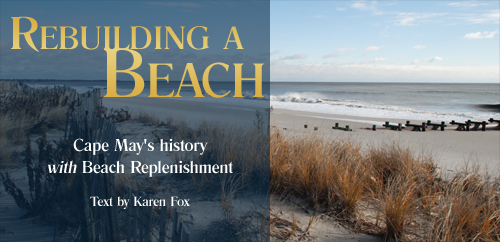|

Manmade beaches in Cape May have been a fact of life for 20 years this year.
This article first ran as Beach Replenishment – A Blessing or a Curse
in Cape May Magazine, June
2007.
Replenishment photos appear courtesy of the U.S. Army Corps of Engineers.
You are lying on the beach on Cape
Island. The breezes plant salty kisses. The sun caresses your skin. The ocean
water tickles your toes. The sound of the sea lulls you into oblivion.
The Island’s beautiful tide-washed
strand creates a place for the very best of natural experiences, but can you
believe most of this seascape is man-made?
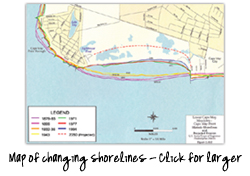 The reality is that engineers have
been altering the tip of New Jersey for 100 years. The reality is that engineers have
been altering the tip of New Jersey for 100 years.
They dug the current 500-acre Cape
May Harbor with mammoth dredges starting in 1903, spreading the dredge spoils
over 3,600 acres of wetlands and oyster beds to create the new East Cape May
development.
The Cape May Inlet jetties
(formerly called Cold Spring jetties), were
completed in 1911, their long arms reaching 4,500 feet into the Atlantic, at the
mouth of the harbor. These inlet jetties are
devils in the struggle against beach erosion.
During World War II, with German
submarines torpedoing ships off Cape May, the U.S. Army Corps of Engineers, in a
wartime emergency act, sliced across the peninsula from the Coast Guard base to
Delaware Bay, digging a three-mile canal to protect U.S. military maneuvers.
Now fast-forward to the 1980s. It
is sad to see that Cape Island beaches are mere slivers of what they were when
the Lenni Lenape Indians, the Unalachtigo, (meaning people who live by the
ocean) fished and hunted the high dunes and broad beaches.
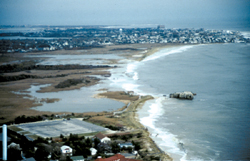 The fast-eroding seashore had
become a major political-economic issue. Energetic young visionaries all around
Cape May were restoring Victorian structures, converting them into comfy B&Bs.
The city was enjoying its new-found halo as a National Historic Landmark.
Positive publicity went nation-wide. Yet the buzz in the tourist industry
produced a big negative: Cape May is a pretty town. Great architecture, nice
gardens, good restaurants. But the beaches are lousy. “You had to plan your
vacation around the tide table and move your blanket inland every five minutes,”
says Vicki Clark, executive director of the Cape May County Chamber of Commerce. The fast-eroding seashore had
become a major political-economic issue. Energetic young visionaries all around
Cape May were restoring Victorian structures, converting them into comfy B&Bs.
The city was enjoying its new-found halo as a National Historic Landmark.
Positive publicity went nation-wide. Yet the buzz in the tourist industry
produced a big negative: Cape May is a pretty town. Great architecture, nice
gardens, good restaurants. But the beaches are lousy. “You had to plan your
vacation around the tide table and move your blanket inland every five minutes,”
says Vicki Clark, executive director of the Cape May County Chamber of Commerce.
Pressure was put on the Army Corps
of Engineers. The Corps finally admitted a big mistake had been made in
anticipating the negative aspects of cutting through the canal 45 years earlier.
The Corps agreed that the design of the canal, with the extended older jetties,
had a devastating affect on Cape Island beaches.
“It’s obvious from aerial
photographs that the north jetty creates a severe offset that interferes with
the river of sand that flows offshore,” says Army Corps Project Engineer Dwight
Pakan. “The sand gets trapped at the north jetty and impedes the natural drift
southward toward beaches in Cape May City, the Cove, the Meadows, the Lighthouse
beach and Cape May Point.”
It took an act of Congress to
decide that what the government had mistakenly taken away, it must return to
Cape Island. The Army Corps of Engineers got the assignment in the late 1970s to
design a beach replenishment project that would dramatically change the
landscape and life of locals and vacationers.
 First evidence of new sand from
Poverty Beach to Pittsburgh Avenue appeared during the winter of 1991. Giant
mountains of sand were pumped in from a dredge offshore, then sculpted and
graded. The monster sand-moving equipment appeared in the mist and fog like
dinosaurs hulking against the sea. First evidence of new sand from
Poverty Beach to Pittsburgh Avenue appeared during the winter of 1991. Giant
mountains of sand were pumped in from a dredge offshore, then sculpted and
graded. The monster sand-moving equipment appeared in the mist and fog like
dinosaurs hulking against the sea.
“There was no beach at all,” says
Pakan. There were the massive concrete and boulder seawall and groins reaching
into the ocean that had been constructed in the 1940s to protect beach front
properties. “We buried them with sand to shape the new beach.” It stretched from
the Coast Guard base south past the deteriorating 1908 Christian Admiral Hotel,
a mere shell of its former self, the once-grand centerpiece of the East Cape May
Real Estate Company development.
Since 1989, the cost of rebuilding
and replenishing Cape Island beaches has topped $50 million with estimates of
more than $100 million to continue replenishing in the future. More than 33
million cubic yards of sand have been redeposited from offshore to create 5.7
miles of expanded beach from the Coast Guard base to Cape May Point. This new
seascape today remains very political, experimental, controversial and one of
the most expensive manufactured beaches in the world.
Depending on which side of the
blanket you are sitting, beach replenishment is considered a blessing – or a
curse.
Taxpayers from all over America
foot the multi-million dollar bill to build the beaches. And taxpayers, through
Congress, have promised to continue paying for replenishment for 50 years after
the initial projects are completed.
Despite the commitment, every year
is a struggle to secure the money. “It’s a forever challenge to convince midwest
and mountain representatives that beach replenishment is not about a sun tan,
but bread and butter issues,” says Congressman Frank LoBiondo “If there’s no
beach, there are no tourists, no businesses, no jobs, the ripple effects are
devastating. Likewise, the beaches and dunes protect lives and property. Without
this system in place we would suffer the consequences of a storm direct hit.
Remember Katrina?”
There is no debating that beaches
are the lifeblood of the economy. The lust for the sea experience generates
billions in vacation dollars and real estate fortunes. Many blessings, indeed.
But there is danger lurking along
man-made beaches where high surf breaks closer to the beach and there are
sudden drop-offs and step-offs in the ocean where the imported sand has not
stabilized to form a gentle slope found on natural beaches. There are invisible
cavities near stone groins, aging steel and wooden piers that have been
blanketed with sand.
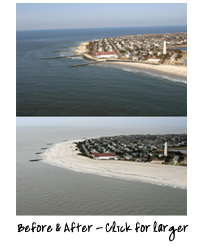 Veteran beach lovers in Cape May
Point were angry the first summer after the 2004 winter beach replenishment.
They were vocal about dangerous holes and drop-offs, new rip currents and rough
imported sand. They were accustomed to narrow tide-cooled sloping beaches of the
finest sand in the world. Veteran beach lovers in Cape May
Point were angry the first summer after the 2004 winter beach replenishment.
They were vocal about dangerous holes and drop-offs, new rip currents and rough
imported sand. They were accustomed to narrow tide-cooled sloping beaches of the
finest sand in the world.
Former Mayor Malcolm Fraser, an
engineer, told the upset beachgoers, “Patience. We need to wait for nature to
take its course stabilizing the new beach. The tides will wash over it,
hardening the beach in place. Natural sands will drift in, and begin to collect
as is to happen with successful beach replenishment.”
Patience and stubbornness are
Fraser traits that have been fundamental to building the 2.7 miles of new beach
from the 3rd Avenue Cove in Cape May to Cape May Point.
The nuns at St. Mary By-the-Sea
prayed for a miracle when they realized their massive picturesque summer retreat
house at the Point was threatening to fall into the sea.
(Cape May Magazine, Fall 2006)
You could say it’s a miracle that Mayor Fraser was able to use an obscure
executive order signed by President George Bush in 1991 allowing the Army Corps
a loophole to protect threatened, but critical wildlife habitats. In this case,
it is Cape May’s Migratory Refuge.
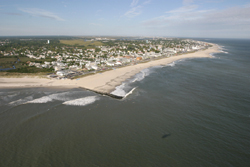 Mayor Fraser’s motivation? Without
success his little town of 240 cottage dwellers might wash away in major storms
as neighboring South Cape May did a century ago. The World War II bunker where
he proposed marriage to his wife in 1953 now stood on pilings in the surf. The
wetlands, known as the Lower Cape Meadows, home to the Migratory Bird Refuge at
Cape May Point State Park, near the Lighthouse,
were inundated with salt water when Hurricane Gloria hit in 1985 and broke
dunes. Storms in 1991 breached rebuilt dunes a half dozen times and contaminated
the fresh water. Mayor Fraser’s motivation? Without
success his little town of 240 cottage dwellers might wash away in major storms
as neighboring South Cape May did a century ago. The World War II bunker where
he proposed marriage to his wife in 1953 now stood on pilings in the surf. The
wetlands, known as the Lower Cape Meadows, home to the Migratory Bird Refuge at
Cape May Point State Park, near the Lighthouse,
were inundated with salt water when Hurricane Gloria hit in 1985 and broke
dunes. Storms in 1991 breached rebuilt dunes a half dozen times and contaminated
the fresh water.
Sometimes it seemed a losing
proposition, but Mayor Fraser never gave up. “I promised my bride 53 years ago
she would always live in Cape May Point,” he says. “It was a pre-nuptial
agreement.”
A decade of studying, politicking
with Congress and planning with the Army Corps of Engineers resulted in the 2004
project that pumped in 1.7 million cubic yards of sand at the cost of 15 million
dollars. High dunes were constructed over massive cores of gravel and clay.
Where there once was sea and the ghosts of South Cape May, a wide expanse of
beach stretched toward the Atlantic. The Lighthouse beaches quadrupled in size.
Dunes now protect the nuns’ 150-year-old St. Mary’s and Point cottages. And the
Army bunker where Mayor Fraser proposed marriage has sand around its feet.
The most dramatic change in the
landscape is in East Cape May where developers went bankrupt at the turn of the
century. Once the new beaches were built in 1991, the neighborhood flooding that
happened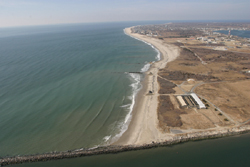 with every fierce nor’easter and hurricane became a bad memory. When the Christian Admiral was torn down in 1996, the monopoly game began in earnest. with every fierce nor’easter and hurricane became a bad memory. When the Christian Admiral was torn down in 1996, the monopoly game began in earnest.
Called the Admiral Beach Estates,
the site of the old hotel was subdivided into 26 lots. Beachfront lots
sold for more than $400,000. Now, 10 years later, there are a couple dozen new
multi-million dollar mansions, and one beachfront lot remaining. It was listed
recently at more than $3.5 million! Some of the lots have been flipped several
times, fortunes being made. Residents were living on highly escalated land, but
they lost their private tiny beaches hidden by the seawall.
As this
story is written, a mean nor’easter is battering Cape Island. It’s dusk at Cape
May Point. Malcolm Fraser pulls on his slicker and boots, a slight figure,
bracing against 55
mph winds at a beach look-out. Into the darkness he
sees his beaches are holding. He returns to his cottage on Lake Lily. “We
survived another one,” he says to his wife.
Beach Replenishment Update
That rolling thunder heard in
Cape May this winter brings promise of more sand on the beaches next summer. As
many as 360 triple-axel trucks, loaded with sand, are tooling down Delaware
Avenue each day to the Coast Guard base until 126,000 cubic yards, or 151,640
tons of sand is dumped there. The truck cavalcade is expected to be in action 30
to 40 days, depending on weather.
The sand is being deposited on an
old air strip, then moved and spread on “feeder” beaches at the Coast Guard
base. The idea is to let nature take its course, and allow the tides to move the
sand down the public beaches from Poverty Beach west to the Cove and on down to
the bird sanctuary in Lower Township.
Originally the Army Corps of
Engineers plan called for 360,000 cubic yards of sand for this phase of Cape May
beach replenishment. It was to have been accomplished, as it has in the past,
but piping sand from the ocean onto the beaches. However, the cost became cost
prohibitive, much more so than the government had estimated. That’s why it was
decided to truck in the sand at a cost of $2.3 million.
The Army Corps has been
replenishing Cape May beaches since 1989, when the original reconstruction
began, plus eight refilling projects about every two years.
The fact that there is less sand
available this year is viewed by some as positive since less sand produces a
more gradual slope, creating safer beaches for swimmers and surfers. In the
past, large sand deposits have resulted in tides digging out sudden steep
step-offs which have been blamed for recreational accidents.
There has been some concern voiced
about the quality of sand trucked in from sandpits. According to Project Manager
Dwight Pakan, the contractor Albrecht and Heun will supply clean sand from its
pits at Cape May Court House that meet specifications and will mix with existing
sand on the beaches. “The sand should be no different than what is now on the
beach,” says Pakan. “In 2000, we placed trucked-in quarry sand on Cape May Point
beaches with no problems.”
Some of Cape May Point’s beaches
that are protected by offshore breakwaters have become so stabilized, they are
now uneven with the beaches washed by ocean tides. These stabilized beaches
stretch 20-30 feet further into the water, and cause uneven footing for
swimmers.
Cape May Point officials have
asked the Army Corps to remove some of that sand and place it on the Meadows
(bird sanctuary) beaches. That contract was awarded December 10th.
Bulldozers and haulers are expected to complete the project by March 2009.
|
